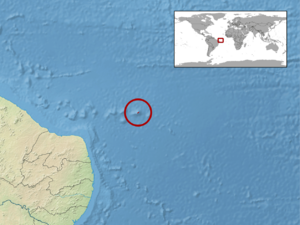Ridley's worm lizard facts for kids
Quick facts for kids Ridley's worm lizard |
|
|---|---|
| Conservation status | |
| Scientific classification | |
| Genus: |
Amphisbaena
|
| Species: |
ridleyi
|
 |
|
The Amphisbaena ridleyi, also known as Ridley's worm lizard or the Noronha worm lizard, is a special type of reptile. It belongs to a group called amphisbaenians, which are sometimes called "worm lizards" because of how they look. This animal is found only on the island of Fernando de Noronha, off the coast of Brazil. It is one of only two native reptiles living on that island.
About Its Name
In 1503, an Italian explorer named Amerigo Vespucci might have visited Fernando de Noronha. He wrote about seeing "some snakes" on the island. Even though the Ridley's worm lizard is not a true snake, it looks very similar. So, it's likely that Vespucci's crew saw these worm lizards. He also mentioned "lizards with two tails" and "very big rats," which were probably the Trachylepis atlantica lizard and the Noronhomys vespuccii rat.
Later, in 1887, a botanist named Henry Nicholas Ridley collected 16 of these worm lizards on the island. These specimens were sent to the British Museum of Natural History. In 1890, a scientist named George Albert Boulenger officially described the species and named it Amphisbaena ridleyi after Ridley.
The first part of its name, Amphisbaena, comes from two Greek words: amphis (meaning "both ways") and bainein (meaning "to go"). This name fits because the worm lizard's tail looks a lot like its head. This makes it seem like it could move forward or backward with either end!
Where It Lives
The Ridley's worm lizard lives on Fernando de Noronha, a small group of volcanic islands. These islands are about 345 kilometers (214 miles) off the northeastern coast of Brazil in the Atlantic Ocean.
These worm lizards are quite common in good habitats. Scientists have found them easily in forests by simply turning over stones. You might even spot them warming up in the sun on a rock called Morro de Pico.
What It Looks Like
Even though the Ridley's worm lizard looks a bit like a snake, it has special features that make it different. For example, to fit its narrow body, its right lung is smaller. In snakes, it's usually the left lung that is smaller. These worm lizards typically grow to be about 25 centimeters (10 inches) long.
The Ridley's worm lizard has a strong head with a wide snout that blends into its neck. Most of its skull is solid bone. It has a unique single tooth in the middle of its upper jaw. It doesn't have outer ears, and its eyes are set deep in its head, covered by skin and scales.
Its body is long and its tail looks a bit like its head. It doesn't have legs, but it does have tiny remains of hip and shoulder bones hidden inside its body muscles. The tail is only loosely attached to its body. The worm lizard moves by using an accordion-like motion, where its skin moves and its body seems to slide along. It can also move backward just as easily!
What It Eats
The Ridley's worm lizard is a carnivore, meaning it eats meat. It has blunt, interlocking teeth that are perfect for crushing its prey. It mainly eats snails, especially a type called Hyperaulax ridleyi. It also eats other small creatures without backbones, like insects. This worm lizard is the only amphisbaenian known to be specially adapted to eat hard foods like snails.
During dry periods, when food might be scarce, the Ridley's worm lizard can climb up the trunks of Mulungu trees. There, it drinks nectar from the flowers to get energy.
How It Reproduces
The Ridley's worm lizard is oviparous. This means that the female lays eggs, and the young hatch from these eggs.
See also
- List of reptiles of Brazil



